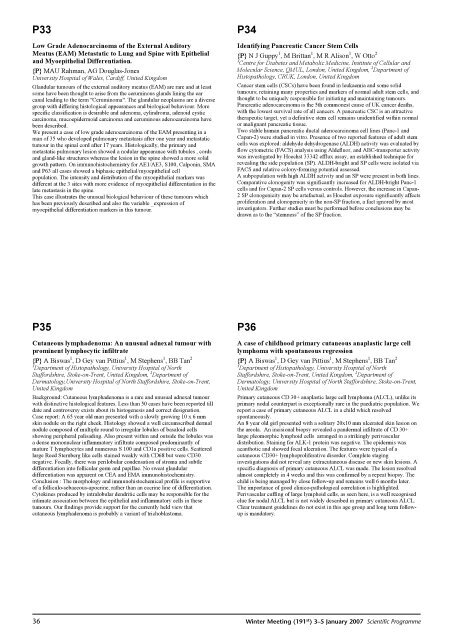2007 Winter Meeting - London - The Pathological Society of Great ...
2007 Winter Meeting - London - The Pathological Society of Great ...
2007 Winter Meeting - London - The Pathological Society of Great ...
- No tags were found...
You also want an ePaper? Increase the reach of your titles
YUMPU automatically turns print PDFs into web optimized ePapers that Google loves.
P33Low Grade Adenocarcinoma <strong>of</strong> the External AuditoryMeatus (EAM) Metastatic to Lung and Spine with Epithelialand Myoepithelial Differentiation.{P} MAU Rahman, AG Douglas-JonesUniversity Hospital <strong>of</strong> Wales, Cardiff, United KingdomGlandular tumours <strong>of</strong> the external auditory meatus (EAM) are rare and at leastsome have been thought to arise from the ceruminous glands lining the earcanal leading to the term "Ceruminoma". <strong>The</strong> glandular neoplasms are a diversegroup with differing histological appearances and biological behaviour. Morespecific classification is desirable and adenoma, cylindroma, adenoid cysticcarcinoma, mucoepidermoid carcinoma and ceruminous adenocarcinoma havebeen described.We present a case <strong>of</strong> low grade adenocarcinoma <strong>of</strong> the EAM presenting in aman <strong>of</strong> 35 who developed pulmonary metastasis after one year and metastatictumour in the spinal cord after 17 years. Histologically, the primary andmetastatic pulmonary lesion showed a nodular appearance with tubules , cordsand gland-like structures whereas the lesion in the spine showed a more solidgrowth pattern. On immunohistochemistry for AE1/AE3, S100, Calponin, SMAand P63 all cases showed a biphasic epithelial/myoepithelial cellpopulation. <strong>The</strong> intensity and distribution <strong>of</strong> the myoepithelial markers wasdifferent at the 3 sites with more evidence <strong>of</strong> myoepithelial differentiation in thelate metastasis in the spine.This case illustrates the unusual biological behaviour <strong>of</strong> these tumours whichhas been previously described and also the variable _expression <strong>of</strong>myoepithelial differentiation markers in this tumour.P34Identifying Pancreatic Cancer Stem Cells{P} N J Guppy 1 , M Brittan 1 , M R Alison 1 ,WOtto 21 Centre for Diabetes and Metabolic Medicine, Institute <strong>of</strong> Cellular andMolecular Science, QMUL, <strong>London</strong>, United Kingdom, 2 Department <strong>of</strong>Histopathology, CRUK, <strong>London</strong>, United KingdomCancer stem cells (CSCs) have been found in leukaemia and some solidtumours; retaining many properties and markers <strong>of</strong> normal adult stem cells, andthought to be uniquely responsible for initiating and maintaining tumours.Pancreatic adenocarcinoma is the 5th commonest cause <strong>of</strong> UK cancer deaths,with the lowest survival rate <strong>of</strong> all cancers. A pancreatic CSC is an attractivetherapeutic target, yet a definitive stem cell remains unidentified within normalor malignant pancreatic tissue.Two stable human pancreatic ductal adenocarcinoma cell lines (Panc-1 andCapan-2) were studied in vitro. Presence <strong>of</strong> two reported features <strong>of</strong> adult stemcells was explored: aldehyde dehydrogenase (ALDH) activity was evaluated byflow cytometric (FACS) analysis using Aldefluor, and ABC-transporter activitywas investigated by Hoechst 33342 efflux assay, an established technique forrevealing the side population (SP). ALDH-bright and SP cells were isolated viaFACS and relative colony-forming potential assessed.A subpopulation with high ALDH activity and an SP were present in both lines.Comparative clonogenity was significantly increased for ALDH-bright Panc-1cells and for Capan-2 SP cells versus controls. However, the increase in Capan-2 SP clonogenicity may be artefactual, as Hoechst exposure significantly affectsproliferation and clonogenicity in the non-SP fraction, a fact ignored by mostinvestigators. Further studies must be performed before conclusions may bedrawn as to the “stemness” <strong>of</strong> the SP fraction.P35Cutaneous lymphadenoma: An unusual adnexal tumour withprominent lymphocytic infiltrate{P} A Biswas 1 , D Gey van Pittius 1 , M Stephens 1 ,BB Tan 21 Department <strong>of</strong> Histopathology, University Hospital <strong>of</strong> NorthStaffordshire, Stoke-on-Trent, United Kingdom, 2 Department <strong>of</strong>Dermatology,University Hospital <strong>of</strong> North Staffordshire, Stoke-on-Trent,United KingdomBackground: Cutaneous lymphadenoma is a rare and unusual adnexal tumourwith distinctive histological features. Less than 50 cases have been reported tilldate and controversy exists about its histogenesis and correct designation.Case report: A 65 year old man presented with a slowly growing 10 x 6 mmskin nodule on the right cheek. Histology showed a well circumscribed dermalnodule composed <strong>of</strong> multiple round to irregular lobules <strong>of</strong> basaloid cellsshowing peripheral palisading. Also present within and outside the lobules wasa dense mononuclear inflammatory infiltrate composed predominantly <strong>of</strong>mature T lymphocytes and numerous S 100 and CD1a positive cells. Scatteredlarge Reed Sternberg like cells stained weakly with CD68 but were CD30negative. Focally, there was perilobular condensation <strong>of</strong> stroma and subtledifferentiation into follicular germ and papillae. No sweat glandulardifferentiation was apparent on CEA and EMA immunohistochemistry.Conclusion : <strong>The</strong> morphology and immunohistochemical pr<strong>of</strong>ile is supportive<strong>of</strong> a folliculo-sebaceous-apocrine, rather than an eccrine line <strong>of</strong> differentiation.Cytokines produced by intralobular dendritic cells may be responsible for theintimate association between the epithelial and inflammatory cells in thesetumours. Our findings provide support for the currently held view thatcutaneous lymphadenoma is probably a variant <strong>of</strong> trichoblastoma.P36A case <strong>of</strong> childhood primary cutaneous anaplastic large celllymphoma with spontaneous regression{P} A Biswas 1 , D Gey van Pittius 1 , M Stephens 1 ,BB Tan 21 Department <strong>of</strong> Histopathology, University Hospital <strong>of</strong> NorthStaffordshire, Stoke-on-Trent, United Kingdom, 2 Department <strong>of</strong>Dermatology, University Hospital <strong>of</strong> North Staffordshire, Stoke-on-Trent,United KingdomPrimary cutaneous CD 30+ anaplastic large cell lymphoma (ALCL), unlike itsprimary nodal counterpart is exceptionally rare in the paediatric population. Wereport a case <strong>of</strong> primary cutaneous ALCL in a child which resolvedspontaneously.An 8 year old girl presented with a solitary 20x10 mm ulcerated skin lesion onthe areola. An incisional biopsy revealed a pandermal infiltrate <strong>of</strong> CD 30+large pleomorphic lymphoid cells arranged in a strikingly perivasculardistribution. Staining for ALK-1 protein was negative. <strong>The</strong> epidermis wasacanthotic and showed focal ulceration. <strong>The</strong> features were typical <strong>of</strong> acutaneous CD30+ lymphoproliferative disorder. Complete staginginvestigations did not reveal any extracutaneous disease or new skin lesions. Aspecific diagnosis <strong>of</strong> primary cutaneous ALCL was made. <strong>The</strong> lesion resolvedalmost completely in 4 weeks and this was confirmed by a repeat biopsy. <strong>The</strong>child is being managed by close follow-up and remains well 6 months later.<strong>The</strong> importance <strong>of</strong> good clinico-pathological correlation is highlighted.Perivascular cuffing <strong>of</strong> large lymphoid cells, as seen here, is a well recognisedclue for nodal ALCL but is not widely described in primary cutaneous ALCL.Clear treatment guidelines do not exist in this age group and long term followupis mandatory.36 <strong>Winter</strong> <strong>Meeting</strong> (191 st ) 3–5 January <strong>2007</strong> Scientific Programme













